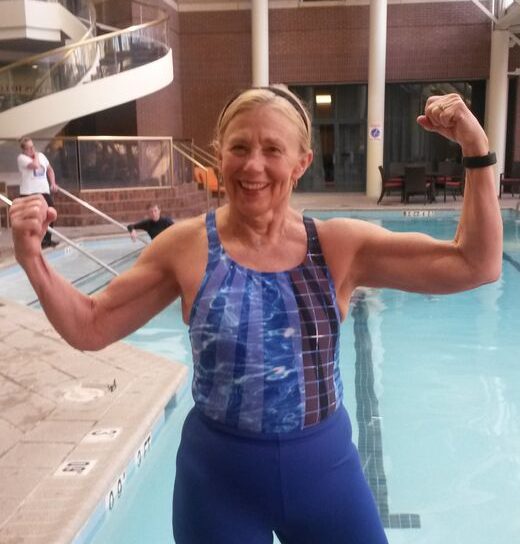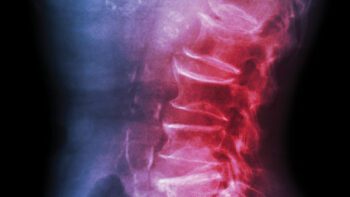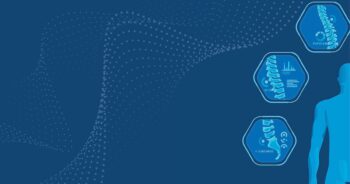
I Am Not A Success Story. Yet.
I am not a success story. Yet. Despite everything, I’ve never doubted my ability to overcome any physical obstacle in my way. This is where Dr. Brian Subach from Virginia Spine Institute enters the picture. It is his task to keep me “screwed” together – quite literally. He is my support and my advisor.
Back Story
My saga began on Christmas Eve 1982 on top of the Zugspitze (highest mountain in Germany). My husband and two oldest sons were busy exploring all of the runs and I agreed to ski with my three year old on the easy slope. I had just spent the past winter as a ski instructor, so to entertain myself, I was skiing the slope backwards and doing 360° turns. As luck would have it, I caught a tip and went down, suffering a complete spiral fracture of the right tibia above the ankle.
Treatment & Recovery
The German doctors wanted to use plates and screws to straighten the fibula. The orthopedist at the American hospital recommended cutting out a section of the right fibula in order to heal the tibia. Being an Army family assigned to Germany, we went with the American recommendation. I spent six months in a cast, but the piece removed from the fibula was too large and it never healed. Regardless, I was on the slopes again by Thanksgiving and was more of a daredevil than ever as I knew I could heal and overcome.
I continued to run, swim, and ski. Physical activity and fitness drive me to push myself beyond the ordinary. All was going smoothly until the mid-1990s when severe ankle pain led to the discovery that I had lost the cartilage in my right ankle because the right lower leg had never set straight. This led to arthroscopic surgery followed by a simple fusion that failed within the year. By now, I had completed my doctorate and was teaching at Northern Virginia Community College (NVCC) – Physical Education of course – every activity and lecture course offered. Next they found a stress fracture near the original tibial break. I spent that summer in a cast, but I taught through all of it. I remember when the cast was removed after the second fusion that my first words were that the right foot didn’t touch the ground where I expected.
First red flag. That’s when I found Aquatic Therapy & Rehab Institute and soon began teaching for them, in addition to the NVCC. I also got certified in Aquatic Exercise and ran that program at the pool where I had been swimming for years.
I can look at my mother and my sister and see a definite genetic and environmental link in the progression of symptoms. The past ten years have been a journey. I was being followed by a military orthopedic spine specialist but when my gynecologist asked him to re-check my back, he was shocked to find extreme scoliosis and rotation that had developed within a year. Solution – nine level fusion.
Within weeks I was teaching again – aquatics, yoga, Pilates, ballroom dance, and fitness lectures. In barely a year, that fusion had failed and a complete fusion from T2 to the sacrum was required. Before I agreed to this, I first met Dr. Subach who agreed that this was necessary. Because of insurance, it was done through the military. The surgery was posterior and anterior, with major complications. At this point I limited my teaching at the college but not the aquatics.
In less than two years, I was having pain again that I thought was sciatica. I went to Dr. Subach for help. He found a broken screw. On my way home from seeing Dr. Subach, my car was rear-ended. Minor inconvenience as two days later in the train station in New York City, I was pushed backwards down an escalator and trapped on my back. I was thankful I could still move. In extreme pain and bruised, we made it to the Broadway play that night, formal dinner the next night, and then flew to Germany for a conference and vacation. When I returned, Dr. Subach removed the pieces of the broken screw and with his expertise, I required no pain medication. The next year the second ankle fusion required a triple arthrodesis.
Today
I continue to swim 10,000 to 12,000 yards per week, do deep water running two days a week for 45 minutes, and weight training. I am a senior instructor for the Aquatic Therapy & Rehab Institute and continue to develop and teach new courses for them and the Aquatic Exercise Association. I travel and train internationally. I am still a member of my masters swim team. I present at the International Aquatic Exercise Association conference and sit on their research board. I am a board member and very involved with many aquatic companies, including the International Swimming Hall of Fame to which I was inducted five years ago. I developed and conducted the study on Aquatic Programs for Wounded Warriors for the Army’s Surgeon General in 2010. I followed that with developing the AMP-IT (Aquatics Maximum Power-Intense Training) that is now required of every Marine. I spent the past year working with Warriors with traumatic brain injuries and post-traumatic stress disorder on defining a nonpharmacological intervention.
I schedule regular appointments with Dr. Subach so that I can continue my active lifestyle. Last year he found another broken screw, but the decision is to not touch it unless it causes symptoms. I repeat – I am not a success story. I am still a challenge in progress. What is the bottom line? Most likely it goes back to the broken leg not healing correctly, leading to uneven leg length, and ultimately leading to my spinal issues. If the skeletal system is weakened or misaligned, another has to take on its works. The song about each bone being connected to the next one is true.
I continue to run five miles a day in addition to swimming, golf, skiing, and teaching. With each ankle fusion, I lost some length in the ankle joint
that eventually led to a lifelong slight scoliosis to a significant diagnosis that required surgery. The water is my environment where any limitations disappear.
The Virginia Spine Institute and the Spinal Research Foundation offer the most outstanding care and options. I wish I had been with them on this journey the entire time. Never doubt what you can do. Persistent perseverance lets me continue to live and love life to the fullest and to mentor others.


